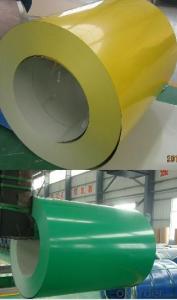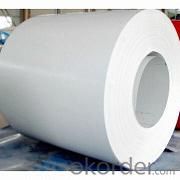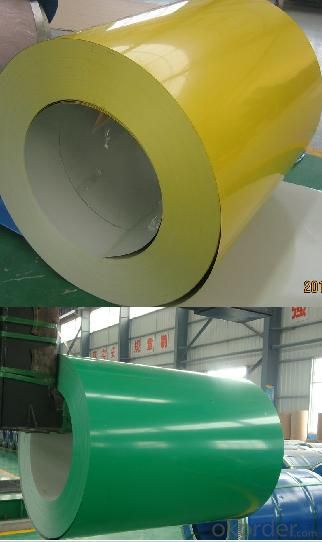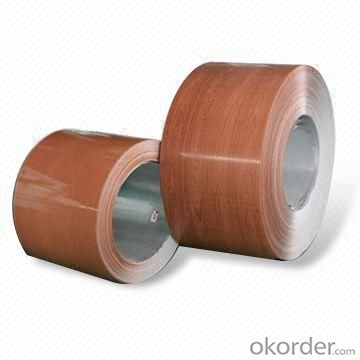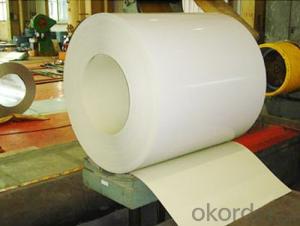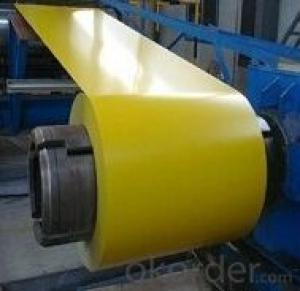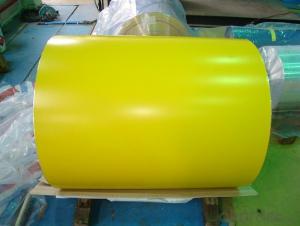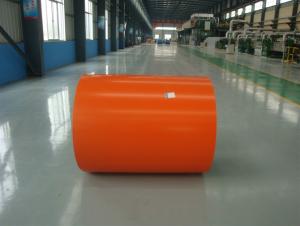Prepainted steel coils Hot sale white color
- Loading Port:
- Shanghai
- Payment Terms:
- TT OR LC
- Min Order Qty:
- 50 m.t.
- Supply Capability:
- 10000 m.t./month
OKorder Service Pledge
OKorder Financial Service
You Might Also Like
Quick Details
| Standard: | AISI,ASTM,DIN,JIS | Grade: | steel | Thickness: | 0.17-1.5mm |
| Place of Origin: | China (Mainland) | Brand Name: | CNBM | Model Number: | SGCC Q195L, Q235, DX51D |
| Type: | Steel Coil | Technique: | Hot Rolled,hot dip | Surface Treatment: | Coated |
| Application: | Flange Plate | Special Use: | Steel | Width: | 600-1250mm |
| Length: | 2000-6000mm |
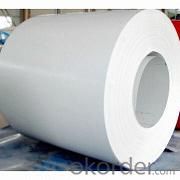
Our Advantages
1. more than 10 years experiences in steel business
2. good quality
3. competitive price
4. meet your needs via reprocessing
5. excellent service
6. short delivery time
7. long mutual beneficial business cooperation
8. certificate: ISO9001
| Commodity | Prepanited steel coil |
| Grade | JIS G3302(SGCC), DX51D, EN10142, GB/T2518-2004, ASTM 653 |
| Standard | ASTM, AISI, DIN, GB |
| Types | Commercial / Drawing / Deep Drawing / Structural quality |
| Width | 500/650/726/820/914/1000/1200/1219/1220/1250mm |
| Thickness | 0.16-1.2mm (0.14-0.5mm is the most advantage thickness) |
| Type of coating | Galvanized |
| Zinc / PE coating | Z60-275g/m2 ,12-20μm(top)/7-10μm(bottom) |
| Surface | RAL System as per customers request |
| ID coil | 508mm |
| Coil weight | 4-6MT |
| Package | Properly packed for ocean freight exportation |
| Application | Industrial panels, roofing and siding for painting |
| Payment terms | 30%TT in advance+70% TT or irrevocable 100%L/C at sight |
| Delivery time | 25 days after recepit of 30% TT or L/C |
PACKING
4 eye bands and 4 circumferential bands in steel, galvanized metal fluted rings on inner and outer edges, galvanized metal & waterproof paper wall protection disk, galvanized metal & waterproof paper around circumference and bore protection
FAQ
We have organized several common questions for our clients,may help you sincerely:
1)How to guarantee the quality of the products?
We have established the international advanced quality management system,every link from raw material to final product we have strict quality test;We resolutely put an end to unqualified products flowing into the market. At the same time, we will provide necessary follow-up service assurance.
2)How long can we receive the product after purchase?
In the purchase of product within 20-25 days, we will arrange the factory delivery as soon as possible. The pacific time of receiving is related to the state and position of customers. Commonly 15 to 30 days can be served.
3)Do you have necessary certificate or inspection to make sure we can import smoothly?
Syringes are CE,FDA approved. And we supplied main nations in the world.
- Q: How are steel coils used in the packaging industry?
- Steel coils are used in the packaging industry to create durable and sturdy packaging materials, such as metal strapping and steel bands. These coils are commonly used to secure and protect heavy or bulky items during transportation, ensuring that the packaging remains intact and resistant to damage.
- Q: Why is iron used to create steel? Why not other elements?
- iron came before steel. iron is what was discovered that, under certain circumstances, became a stronger metal: steel. that is why. its like asking why copper is in bronze. because what we call bronze, is an alloy of copper and tin. if you give a more detailed question, i may be able to give a more detailed answer.
- Q: What are the challenges in coil slitting?
- Coil slitting, also known as coil cutting, involves the process of cutting large metal coils into narrower strips. However, there are several challenges associated with this process. One challenge is maintaining precision during slitting, as any deviation can result in uneven strip widths or poor edge quality. Another challenge is managing the tension of the coil throughout the slitting process to prevent material distortion or breakage. Additionally, handling and transporting the slit coils can be challenging due to their length and weight. Overall, ensuring accuracy, maintaining proper tension, and effectively handling the slit coils are some of the key challenges faced in coil slitting.
- Q: How are steel coils used in the production of wind turbine components?
- Steel coils are used in the production of wind turbine components for their strength and durability. These coils are typically formed into various shapes and sizes to create structural elements such as towers, frames, and foundations. The steel coils are also used to manufacture critical parts like rotor blades, gearboxes, and generator housings, ensuring the turbines withstand harsh environmental conditions and operate efficiently.
- Q: What is the process of pickling and oiling steel coils?
- The process of pickling and oiling steel coils involves several steps to ensure the quality and protection of the steel. Firstly, pickling is the process of removing impurities and scale from the surface of the steel coil. This is typically done by immersing the coil in an acid bath, such as hydrochloric acid or sulfuric acid, which helps to dissolve any oxides, rust, or other contaminants present on the surface. This step is crucial as it prepares the steel for further processing and prevents any potential defects or corrosion. After pickling, the steel coils are rinsed with water to remove any residual acid and then dried. Once the coils are clean and dry, they are then coated with a layer of oil to provide temporary corrosion protection and lubrication during subsequent handling and transport. The oil coating helps to prevent the steel from rusting or oxidizing before it is further processed or used in various applications. The oiling process can be done in several ways. One common method is by applying the oil using a roller or brush, ensuring that the entire surface of the coil is evenly coated. Alternatively, the coils can be passed through a bath or spray chamber where the oil is applied. The type of oil used can vary depending on the specific requirements of the steel and its intended use. Some common oils include mineral oil, synthetic oils, or specialized rust-preventive coatings. Once the oiling process is complete, the steel coils are typically stacked, wrapped, or packaged for storage or transportation. It is important to handle the coils carefully to avoid damaging the oil coating and compromising the corrosion protection. Overall, pickling and oiling steel coils are essential steps in the steel manufacturing process to ensure the quality, cleanliness, and protection of the steel, ultimately extending its lifespan and enhancing its performance in various applications.
- Q: How do steel coils contribute to the energy sector?
- Various contributions are made by steel coils to the energy sector. Firstly, they play a crucial role in the manufacturing of essential equipment and infrastructure for energy production and distribution. Examples include power plants, transmission towers, and pipelines. These structures necessitate robust and durable materials, which are provided by steel coils, ensuring the required strength and reliability. Additionally, steel coils have a significant impact on the renewable energy sector. They are utilized in the production of wind turbines and solar panels. For wind turbines, steel coils are necessary for constructing the towers, while solar panels rely on steel frames for support and durability. With the increasing demand for renewable energy sources, the utilization of steel coils in this sector is expected to rise correspondingly. Moreover, steel coils are integral in the manufacturing of electrical transformers. Transformers are vital components in the energy sector as they facilitate the transmission and distribution of electricity. The core of the transformer, responsible for efficient energy transfer, is created using steel coils. The quality and dependability of the steel coils used in transformers are crucial to ensure the smooth functioning of the electrical grid. In addition to their direct applications, steel coils also indirectly contribute to the energy sector. Steel is a recyclable material, and the recycling process consumes less energy compared to the production of new steel. By employing recycled steel coils, the energy sector can decrease its carbon footprint and contribute to a more sustainable and environmentally friendly energy production process. In summary, steel coils are an indispensable component in the energy sector. They are utilized in manufacturing equipment and infrastructure, including power plants, transmission towers, wind turbines, solar panels, and electrical transformers. Furthermore, the recyclability of steel enhances the sustainability of the energy sector.
- Q: How are steel coils used in the manufacturing of wires?
- Steel coils are used in the manufacturing of wires by being uncoiled and then fed through a series of machines where they are drawn, stretched, and twisted to the desired diameter and shape. This process helps to strengthen the wires and make them more flexible for various applications such as electrical wiring, construction, and manufacturing.
- Q: Can steel coils be used in corrosive environments?
- Yes, steel coils can be used in corrosive environments, but their performance will depend on the type of steel and the severity of the corrosive environment. Stainless steel coils, for example, are highly resistant to corrosion and can be used in a wide range of corrosive environments, including those with high levels of moisture, chemicals, or salt. However, other types of steel coils may require additional protective measures, such as coatings or galvanization, to enhance their resistance to corrosion. It is important to consider the specific corrosive factors present in the environment and choose the appropriate type of steel and protective measures to ensure the longevity and durability of the steel coils.
- Q: How did the growth of the steel industry influence the development of other industries?
- At least three ways: 1. Steel as a material that other industries could use to do things that couldn't be done before (for example, construction (skyscrapers, long bridges, etc.)) or could now be done at much lower cost and hence increased the size of the industry (automobiles, bearings, etc.)
- Q: density of mild steel (MS) is 7850 KG per metre cube , but i want to know the density of stainless steel
- Density Of Stainless Steel
Send your message to us
Prepainted steel coils Hot sale white color
- Loading Port:
- Shanghai
- Payment Terms:
- TT OR LC
- Min Order Qty:
- 50 m.t.
- Supply Capability:
- 10000 m.t./month
OKorder Service Pledge
OKorder Financial Service
Similar products
Hot products
Hot Searches
Related keywords

